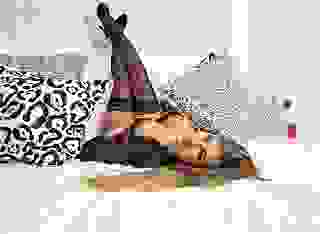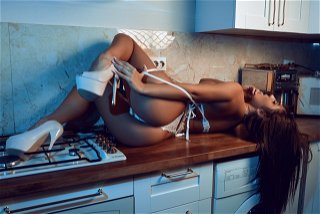Note: You can change font size, font face, and turn on dark mode by clicking the "A" icon tab in the Story Info Box.
You can temporarily switch back to a Classic Literotica® experience during our ongoing public Beta testing. Please consider leaving feedback on issues you experience or suggest improvements.
Click hereHailey sighed deeply. She was worried about failing the test. "I don't know if I can do this," she said. "What if I fail?"
Kim placed her hand on Hailey's shoulder. "You'll do great," she said. " Now, many police departments; such as the San Diego Police Department, include the following features in their law enforcement obstacle course: Stairs and ladders, to climb both up and down, dragging a simulated victim who weighs approx. 150lbs, low-hanging objects which must be avoided, navigating through a series of pylons, fences, which may be 3-6ft in height, tunnels to crawl through, monkey bars that test upper body strength and mobility, and nets, which must be rapidly crawled through." Hailey nodded. "Furthermore, test candidates are given a 3lb vest (approx.) which must be worn throughout the entirety of the exam -- adding to an already difficult challenge and reducing your ability to move fast on the spot."
Hailey nodded. "How long is the course?" Hailey asked.
"The length of police obstacle courses varies, but they tend to average around 450-500 yards in length," Kim said. "The purpose of the obstacle course is clear -- to simulate what a day in the life of a police officer is like. There are many situations in which police officers must navigate their way through often difficult terrain or obstacle-strewn paths to capture suspects. This is physically demanding work and simulates the kind of barriers that officers routinely encounter. Nonetheless, officers are expected to have the physical capability to handle these challenges when and as they arise, no matter how random the barrier or obstacle may be. Before taking the exam, candidates are advised to wear light clothing and rubber-gripped athletic footwear. On the day of your police test, you will be given more detail about what is/is not permitted, and you will also have the chance to ask questions."
Kim and Hailey then got ready. "To pass the obstacle course exam, candidates must be in top physical condition," Kim continued to say. "Though standard exercise regimens are useful, it's imperative that you simulate the obstacle course, and its challenges, as best you can in the weeks and months leading up to the exam. Some departments, such as SDPD, offer candidates the chance to practice their own obstacle course. You should take this opportunity when and as it arises, weather permitting. Most agencies offer weekly or monthly access to their police obstacle course. It also gives you the chance to ask questions if you need to. This kind of experience is invaluable and it helps you not only prepare for obstacles but also the psychological advantage it offers given that you now know what to expect. Going into an obstacle course "blind", without any knowledge of what to expect, is likely to lead to failure."
Hailey nodded and sighed. "I'm nervous," she said.
Kim smiled and nodded. "Remember -- though the police obstacle test is an important part of the police fitness exam, it's worth pointing out that you must prepare for each part of the fitness exam in a proportionate manner" she said. "In other words, do not over-prepare for the obstacle course and lose valuable time preparing for other parts of the fitness exam -- such as the sprint or sit-up/push-up tests. All parts of the exam must be passed. Do not compromise your focus. Make a defined fitness plan and stick to it. You must train different muscle groups associated with each test and not assume that by focusing on the obstacle course that you have the ground covered elsewhere. That is a risk not worth taking. You must take a holistic approach that takes into consideration each part of the fitness test. The same principle applies to other parts of the police officer test -- such as the written exam and police interview test. The strategy is clear: make plans; keep focussed; stay disciplined. That way, you guarantee success at the obstacle course and every other part of the police exam. Let's get started with the pushups, pull-ups, sit-ups, 300 meters sprint, and the 1.5 mile run."
End Flashback....
In Stryker's breeding Arena....
Stryker smiled. She was standing in front of several capsules of clones. She managed to make clones of each of the SuperTeens, the family members and allies.
She then stepped back and watched as a clone of Nora Snow-West named Nadie, exited the capsule and stood in front of Stryker. Stryker smiled and walked over to the young speedster clone. She looked just like the young speedster, but she was Stryker's little pet. "What is your name?" Stryker asked.
"My name is Nadie," the young speedster clone said. "What is your command, Mistress?"
Stryker smiled. "I've given you life and purpose," she said as she walked around the young speedster clone. "What is your purpose?"
"To serve you, my Mistress," Nadie said.
"Excellent," Stryker said. "And how do you serve me?"
Nadie turned her head and looked at Stryker. "Anyway you want, Mistress," she said. "Physically, emotionally and sexually."
Stryker smiled and patted the young clone on the head. She couldn't wait to send this clone to breed with her template. Stryker smiled, pulled down her pants and began to stroke her dick. "I command you to serve your Mistress," she said.
Nadie turned around and saw Stryker's dick. "Yes Mistress," she said as she dropped to her knees and began to suck on Stryker's dick.
Back in the Flashback....
Kim was training Hailey. "The fitness training test will push you to your limits," Kim said. "The minimum point value is 12 to pass the test." Kim smiled. "Let's get started with sit-ups. You need to see how many you can do in a minute."
The number of sit-ups and the point value were listed below;
-2: 29 or below sit-ups.
0: 30-34.
1: 35-36.
2: 37-40.
3: 41-42.
4: 42-46.
5: 47-48.
6: 49-50.
7: 51-52.
8: 53-54.
9: 55-56.
10: 57 and over.
Hailey nodded. She started by lying on her back with her knees bent. Sit ups worked best if the individual did them on a soft surface, such as a mattress. Hailey kept her knees bent at a 90-degree angle, with her feet flat on the floor. People sometimes may be more comfortable if they lie on an exercise mat while they're doing sit ups.
Hailey placed her fingertips on the back of her ears. Her elbows were bent and pointing out at her sides. She cupped the back of her ears with her fingertips -- as opposed to placing them on the back of her head -- can help prevent her from pulling herself up by her neck as she did sit ups. Kim told Hailey that she could also cross her arms over her chest or hold her arms slightly above the floor so they're parallel to her sides.
Hailey lifted her torso up as close to her thighs as possible. She did this with a smooth, steady motion, keeping her feet flat on the floor. When she was done lifting her torso, Hailey's lower back should be off the floor.
Hailey lowered her torso down to the floor so she was back in the starting position. Like she did when she lifted her torso up to her thighs, she used a smooth and steady motion as she lowered it down. Once she was back in the starting position, Hailey could repeat the exercise if she wanted to do more reps.
Hailey kept going. Kim counted as the young detective did the sit-ups. Hailey then stopped because she couldn't do anymore as the time ended. "How did I do?" Hailey asked.
Kim smiled. "You got 55 sit-ups," she said. "Now we're going to do pull-ups."
The pull-ups were not timed. The number of pull-ups and the point value were listed below;
Score Female Range
0 pull-ups: 0
1: 1
2: 2
3: 3
4: 4
5: 5
6: 6
7: 7
8: 8
9: 9
10: 10 or over
Hailey nodded. She walked over to a bar. She jumped up, grabbed the bar with an underhand grip and kept her hands about a shoulder-width apart. Then, she slowly squeezed her biceps to bring her chin closer to the bar.
Hailey managed to get 4 pull-ups done. Kim smiled and nodded. "Very good," Kim said. "Now we're going to do push-ups."
Hailey nodded. "Okay," she said. She assumed a face-down prone position on the floor. She kept her feet together. Her weight should be on her chest. She positioned her hands palms-down on the floor, approximately shoulder width apart. Her hands should be about next to her shoulders, with her elbows pointed towards her toes. If she was on a relatively cushioned surface, such as a carpeted floor, Hailey may also support herself on her fists between the first and second knuckles for a greater challenge. If she was on a less forgiving surface, she would consider investing in some push-up grips, (they look like handles you put on the floor). Hailey curled her toes upward (towards her head). The balls of her feet should touch the ground.
She then raised herself using her arms. At this point, her weight should be supported by her hands and the balls of her feet. She made a straight line from her head to her heels, and contracted her abdominals to keep her hips from sagging. This position is called a 'plank,' which was used for other various exercises. This was the beginning and the end position of a single push up.
Hailey repeated lowering and raising at a steady pace. Each pair counted as a single push up. She did this until she finished her set or she hitted her maximum.
The push-ups were also untimed. The number of push-ups and the point value were listed below;
-2: 4 or below push-ups
0: 5-13
1: 14-18
2: 19-21
3: 22-26
4: 27-29
5: 30-32
6: 33-35
7: 36-38
8: 39-41
9: 42-44
10: 46 and over
Hailey nodded and achieved 33 push-ups.
Kim smiled. "Now we're going to do the 300 meter sprint," she said. "You're going to sprint two full laps around the track." Hailey nodded and got ready to start. "Ready, Set, GOOOOOOOOOOOOO!!!!!!!!!!!!!!??!"
Hailey took off running. The 300-meter sprint was timed. The timing was in seconds and had the following scoring;
-2: 67.5 or over seconds
0: 67.4-65.0
1: 64.9-62.5
2: 62.4-60.0
3: 59.9-57.5
4: 57.4-56.0
5: 55.9-54.0
6: 53.9-53.0
7: 52.9-52.0
8: 51.9-51.0
9: 50.9-50.0
10: 49.9 or below
Hailey completed the two laps in 50.2 seconds. Kim smiled. "Very good," she said. "Now we have the 1.5 mile run. Follow me and try to keep up." Kim and Hailey then proceeded to run. 1.5 mile run was not marked with points, but rather a percentage rating. The following was for a 20 to 29 year old;
Rating: Time (in minutes:seconds)
99: 8:33
95: 10:47
90: 11:43
80: 12:51
70: 13:53
60: 14:24
50: 14:55
40: 15:26
30: 15:57
20: 16:33
10: 17:21
Hailey was able to catch up with Kim and scored 99%.
"Very good," Kim said. "Overall, you scored a mark of 28. You're ready to move on to the next training." Hailey nodded. "Follow me." Kim led Hailey over to another location. "This is the close range weapons training test. Basically, the situation is maybe you're just going on patrol, maybe a civil dispute, whatever it is, you're going into an environment with a short range weapon."
Hailey nodded and smiled. "Guess I have a lot to learn," she said.
Kim smiled and nodded. She pulled out a pair of oakley si anorak - matte black frame & prizm grey lensed glasses. "The Oakley SI Anorak Matte Black Sunglasses with Prizm Grey Lenses combine performance features with a lifestyle design for a pair of sunglasses that easily transition from active adventures to everyday life," Kim said. "The Anorak are a slimmed down and more subtle version of the Oakley Advancer technology that opens airflow to help fight fogging and overheating. The Prizm lenses are designed to enhance color and contrast, allowing you to see more detail."
The lenses were designed as earpieces, and with the press of a button, become sunglasses. They had the following features;
No Fog: Oakley Advancer technology is designed to instantly open airflow to help combat fogging and overheating.
No Slip: Comfortable Unobtainium nosepads to help keep eyewear securely in place.
Lightweight: O Matter frame material helps to provide durability and all-day comfort to keep up with life on-the-go.
Suspect Scanner: They could track the DNA of different people even from a far distance.
Hailey nodded. Kim placed her own lens on her right ear, and Hailey's on the young detective's right ear as well.
"Next, this is your flashlight," Kim continued, holding an LA police gear recon rechargeable flashlight. "The LA Police Gear Recon Rechargeable Flashlight is USB rechargeable, insanely bright, and has a long runtime. It uses one USB rechargeable 18650 battery to produce a blinding 1,000 lumen output. Its brightness for its compact size will astound you, as will the price! LAPG lights keep getting better, and prices stay the same or even drop. The Recon Rechargeable features 3 output modes, High, Medium, and Low."
Hailey nodded and placed her flashlight in her pocket and watched Kim. Hailey was a lesbian. When she was 13 years old, she use to have sleepovers in her girlfriends' beds and rub against them.
When she was 18 years old, she had her first experience with a girl in her class, Bethy Johnson. While the other children were playing outside, Hailey was going down on Bethy, eating the girl's cunt.
One of the teachers saw them, told the parents and Hailey was kicked out of her own house. As she looked at Kim now, those thoughts of other girls and women began to appear in her mind. She shook her head and smiled. "So, what else?" Hailey asked.
Kim smiled. "The next thing before we move on to the close range weapons training test is going through the equipment." She walked over to a set of ammunition and magazines. "Police officers may carry a supply of extra ammunition in case they need to reload their firearms. The ammunition can be stored on the duty belt or in a magazine pouch. Additional rounds of ammunition may be stored in the patrol vehicle." Kim then pointed at the body camera on Hailey's and her own chest. "Although they are not part of the standard police uniform, police body cameras are becoming much more popular these days. Law enforcement departments that have begun using the devices found a substantial decrease in complaints about police behavior. Standard equipment may vary from department to department based on specific needs, but these items cover the basics."
"What if I get shot at?" Hailey asked.
Kim smiled and nodded. "That's why we have a bulletproof vest," she said. "A majority of police officers prefer to use a soft bulletproof vest as part of their equipment as they are less noticeable. This armored vest can protect an officer against attacks with weapons such as knives, pistols, rifles, small explosives, and the like." Suddenly, a police drone flew over their heads. "Although drones are not considered part of the standard equipment worn by officers, they are becoming much more popular with departments across the nation. They can be used to track suspects, search for missing persons, survey a damaged area, and much more."
Hailey nodded and put on her bulletproof vest. It went underneath the navy blue jacket. Kim then did the same thing. "What's the deal with the belt?" Hailey asked.
Kim smiled. "The duty belt makes the equipment easy to carry and readily accessible," she said. "They are typically made of either leather or nylon and are usually black in color. The police duty belt is also known as a gun belt or kit belt." Kim pulled out a pair of handcuffs. "Police handcuffs are probably the most used item in their equipment arsenal. Handcuffs are highly effective to keep the suspect under control and prevent them from causing harm to their person, or those around them. Most officers carry around 2-3 pairs so that they can capture and detain more than one perpetrator."
Kim then handed over Hailey's handgun holster. The handgun holster is designed to carry a firearm in a convenient place. The holster is most often attached to a utility belt, but may also be attached around the upper torso or even the leg. Holsters can be made of leather, nylon, or plastic. Hailey attached her holster to the right side of her body. Kim smiled and attached her holster to the left side of her body.
Next were rubber gloves. Many cops keep one or more pairs of rubber gloves in their patrol cars. The gloves are important to wear when handling crime scene evidence such as weapons, bullets, and other items. This keeps the officer's prints off of the items. In addition, officers wear rubber gloves when examining victims.
The final equipment was the radio. Radios are used by most departments to facilitate communication with dispatch and other officers. The radios are usually attached to the utility belt and are often held with a radio pouch. However, some departments attach the radio to the shoulder area to make it easier for the officer to use. Ten codes are used to help expedite communication.
Kim then proceeded to explain to Hailey a few of the weapons used. The first was the baton (Nightstick). One of the oldest items of police equipment, the baton is generally used to disperse and control crowds of people on the cusp of a riot. Batons also come in handy in protection against unarmed, though aggressive people. In addition, batons are often used to break down windows and doors to free or rescue trapped victims in dangerous situations.
Next was a knife. Knives can be used as a self-defense weapon, or as a cutting tool. A knife can be used to cut a person free of restraint such as a rope or to cut a seat belt if someone is trapped in a vehicle. It is important to note that not all cops carry knives due to the risk factors involved.
The next item was Mace / Pepper Spray. Officers may carry a canister of mace or pepper spray to help neutralize individuals. The spray makes it difficult for the assailant to see and breathe, which gives officers time to subdue the individual and make an arrest.
Next was a Pistol or Firearm. Law enforcement officials face many potentially dangerous situations on any given day. Although they are rarely used, the pistol or firearm is an essential element of the police outfit. The Glock handgun is the preferred weapon of choice for most on-duty police officers. Alternatively, a police officer may choose from a variety of over 20 different types of pistols with models like the 10mm, 9mm,.45cal, and.40cal from the list. While the.40 caliber is most often a firearm of choice, an officer may choose any type or model of pistol.
Next was a Shotgun. Almost every police car is equipped with a standard 12 gauge shotgun, which is used during dangerous encounters with armed criminals. Buck shots are used in the shotgun's magazine, which is the best option for close-range shooting and combat. Most officers carry additional ammunition on their equipment belts. A shootout situation that occurs at over 20 yards will most likely call for use of the shotgun. Police officers have the option to carry a shotgun that shoots bean bags, a non-deadly weapon that is typically used in riot or crowd control situations.
The final weapon was the taser gun. A fairly new addition to the list of police officer equipment, TASER®guns work more effectively when neutralizing a suspect without causing excessive physical harm. On average, TASER guns can travel about 15 feet to latch on to the suspect through layers of clothing and inflict over 50,000 volts of electric current. Enough to leave the suspect temporarily incapacitated allowing the officer opportunity to make the arrest.
Kim smiled. "Now that you have the knowledge," she said. "We'll start with the Firearm Safety Policy.
1. Treat every single gun, with respect, as a loaded gun.
2. Carry only empty guns, taken down or with the action open, into your car, camp and home.








